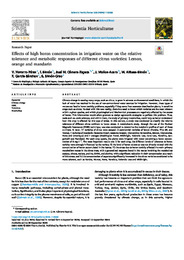Resumen :
Climate change is causing many crops, such as citrus, to grow in adverse environmental conditions, in which the lack of water has resulted in the use of non-conventional water sources for irrigation. However, these types of waters can lead to boron toxicity problems, especially if they come from seawater desalination plants, in sensitive crops such as citrus. To deal with this new reality, there is a need to know which varieties are the most tolerant within a given species, and which physiological and biochemical processes are negatively affected by the excess of boron. This information would allow growers to design agronomic strategies to palliate this problem. Thus, tools such as -omic sciences, and within them, the study of primary metabolites, could help us better understand how this crop is affected by this type of stress. In this context, a study was conducted to classify the relative tolerance of different citrus cultivars to boron stress. A metabolomic study, through the use of the Nuclear Magnetic Resonance (NMR) technique, was also conducted to determine the metabolic profiles of each of these cultivars. In total, 17 varieties of citrus were assayed: 3 commercial varieties of lemon (Eureka, Fino 49, and Verna), 7 varieties of mandarin (Satsuma Owari, Satsuma Iwasaki, Clementina Hernandina, Murcot, Clemenules, Nova and Ortanique) and 7 oranges (Washington Navel, Midknight, Valencia Late, Lane Late, Navelina, Sanguinelli and Navelate). For each crop specie, the plants were irrigated with water containing a boron concentration of 5 mg L−1. The most important results are: i) for each crop, the different levels of tolerance to boron toxicity were strongly influenced by the variety; ii) the level of boron tolerance was not directly related with the concentration of boron accumulated in the leaves; iii) the stress due to boron toxicity affected the main primary metabolism routes in the citrus trees, with a generalized response found in the routes involving the metabolites acetate, citrate, malate, proline, GABA, and alanine, with a significant reduction in their concentration as a result of this stress; and iv) the concentration of aspartate significantly increased in the citrus varieties considered to be more tolerant, such as Eureka, Murcot, Nova, Navelate, Valencia Late and Midknight
|
 La licencia se describe como: Atribución-NonComercial-NoDerivada 4.0 Internacional.
La licencia se describe como: Atribución-NonComercial-NoDerivada 4.0 Internacional.
.png)
